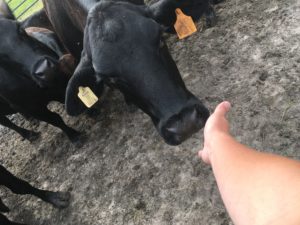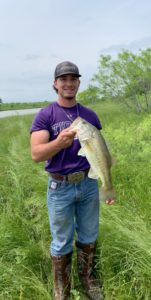Click to see schedule of events
Megan Finley Farm Intern time has come to an end
These past few months have absolutely flown by, and so I find myself at the end of my internship here at Stiles Farm. It has proved to be a valuable experience, being able to put into practice knowledge I already had as well as learn new things, which is exactly how I hoped it would be. Since most of my previous agriculture and livestock experience has been on a small scale, this internship has provided a good platform for witnessing large-scale farming practices. My time here has also provided numerous new contacts within the farming community, which should be of benefit in my future pursuits. To any student wondering if they should apply for an internship, the answer is YES! Whether the internship is during your schooling or after, it can be so beneficial in helping refine your career pursuits and give you the experience employers are looking for. Megan Finley Farm Intern
Jacob Seggern Farm Intern
My time here at stiles farm has come to an end and the time I have spent here on the farm has allowed me to further my education in a working environment. This internship has been a fantastic opportunity to connect with a variety of producers in the local farming community along with business from all over the agricultural industry. I was also very grateful to be a part of a variety of different projects while on the farm such as the fabrication of a water gap and a chicken tractor. I would highly recommend the Stiles Farm internship to anyone this is wanting to get their feet wet in the farming and ranching industry. This is because the farm is a demonstration farm with the purpose of trying a variety of farming and ranching practices.
Bleed Purple!
Jacob Seggern Farm Intern
Wildlife Intern AnMarie Ulery
This week at the farm I continued my point count bird surveys. Over the past few weeks, as the spring migrants have been coming in, I’ve heard several new species such as Grasshopper sparrows, Scissor-tailed flycatchers, Yellow-headed blackbirds, and Dickcissels. Below is a picture that I captured of a male Dickcissel mid-call on one of my survey routes. This week I also wrapped up my spring vegetation surveys. This time of year is ideal for surveying vegetation as many of the forbs are flowering and the grasses are producing seed heads. While on my vegetation survey routes on the south end of the property, I had several exciting encounters. I came across this female red-eared slider laying her eggs, heard a Northern bobwhite calling several days in a row from different survey points, and was warned by a few rattlesnakes that I
stepped a little too close as I was walking by. AnMarie Ulery Wildlife Intern
Wildlife Intern AnMarie Ulery
This week I took some time to survey bud-break of mesquites on the south end of the farm. I looked at both mesquites that were sprayed and were not sprayed last year. By recording the date of bud break of the mesquites that didn’t get sprayed last year, we can determine what time will be the most effective to spray this year. By recording the date of bud break of the mesquites that did get sprayed last year, we are able to determine about what percent were killed, and of the plants that aren’t completely dead, what percentage of each is budding.
This week I also checked the memory cards of the game cameras that I deployed a few weeks ago. I placed several cameras in various locations around the farm that have not yet been surveyed with camera trapping. In addition to this broad surveying, I also placed cameras in a few targeted locations where we have been seeing suspected beaver tracks and feeding sign. After checking these cameras, we were able to confirm the presence of beavers as well as add an unsuspected mammal to our species list, the North American river otter! AnMarie Ulery
Beavers
Farm Interns
The week was kinda slow after the big rain event at Stiles Farm. Planting has slowed while the ground is so wet, but the corn and milo is coming up nicely.
We sorted the cows that have been at head quarters, moving them to different herds as some were replacement heifers and others were second year cows.
At the end of the week we took 13 heifer and bull calves to the Cameron Auction to be sold. Farm Intern Jacob Seggern and Megan Finley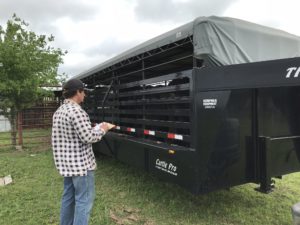
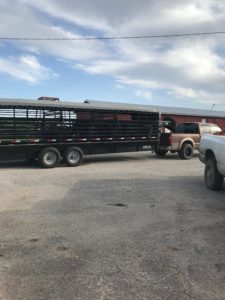
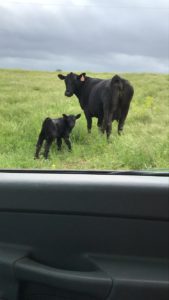

Video of Chicken House Modifications
Farm Interns Megan Finley and Jacob Seggern
The last few weeks have been busy! Many more acres have been planted, in corn and milo. Bulls were purchased and put out to pasture with the herds of cows. The meat chickens were processed, so the only chickens left are the layer pullets who are now allowed to roam the yard during the day.
The vegetable garden has been planted: tomatoes, peppers, beans, etc. But it hasn’t been all work and no play.
An afternoon was spent on one of the tanks fishing, where a few largemouth bass were hooked and thrown back.

Farm interns Megan Finley and Jacob Seggern
Megan Finley Farm Inter -Chicken Update
The chickens are growing so fast! The broilers will be ready for slaughter soon. The chicken tractor has worked out well for them and they are thriving. The layer pullets outgrew their small run and have been moved to a larger area, complete with roosts and nest boxes, though it will still be a few months before they start laying eggs. Once they are well established in the new home, they can be turned out to range in the yard, and will be shut up at night to protect them from predators.
Megan Finley Farm Intern
Jacob Seggern Spring Intern
This week was another one for the books! To start the week off we built a water gap, that had been torn down due to some recent bridge work.

Then we got a few pieces of old tillage equipment running again so that we could incorporate compost and chicken litter into our new garden area.
Finally to finish up the week I did some checking of the sweet corn patch to see how far along the seedlings where



